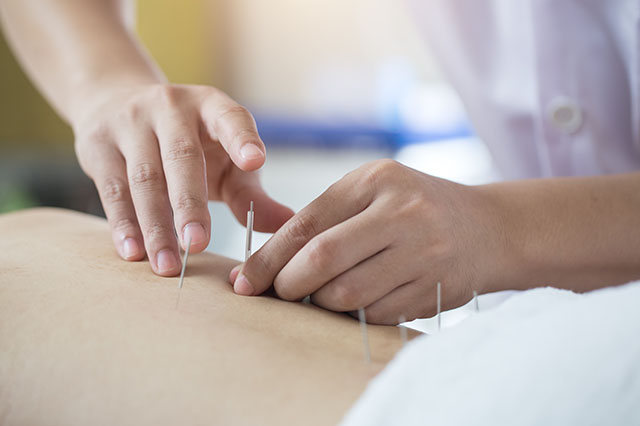Acupuncture
Acupuncture practice comes from traditional Chinese medicine. It is a treatment that uses very thin steel needles inserted into your skin to stimulate specific points. The needles rebalance your body’s energy, or qi, and prompt your body to release natural chemicals to fight the illness or symptom, such as pain.
What does acupuncture treat?
Acupuncture can help treat many types of health issues. Most often, people use it to relieve chronic (long-term) pain, such as:
- Arthritis.
- Back pain, neck pain , Knee pain or muscle pain.
- Headaches and migraines.
- Menstrual cramps.
- Sports injuries.

Pelvic Floor Acupuncture involves needling local soft tissue and ligaments in the areas that have a direct effect on the pelvic floor. Acupuncture helps by releasing taut muscle tissue and fascial adhesions to create more space and range of motion in the tissue. Thus, decreasing pain and improving quality of life.
- Chronic constipation
- Bladder control problems such as urgency or dribbling
- Urinary and fecal incontinence
- Diffuse gluteal pain
- Diffuse lower extremity pain
- Dyspareunia, or pain with intercourse
- Dysmenorrhea (painful periods)
- Endometriosis
- Vulvodynia (causes severe pain, burning, and stinging of the vulva)
- Pain from an episiotomy or scarring
- Pain with urination or defecation
- Prolapse of pelvic and rectal organ
- Scarring from C-Section or other abdominal surgeries
- Tailbone pain
- Pudendal Neuralgia
In women pelvic floor dysfunction can happen:
During pregnancy such as pubic symphysis pain, Pain felt in the front middle of the pubic bone, in the lower back on one or both sides, and/or in the perineum. During history of multiple miscarriages or traumatic births. After surgical intervention such as hysterectomy or laparoscopic surgeries.
In women pelvic floor dysfunction can happen:
During pregnancy such as pubic symphysis pain, Pain felt in the front middle of the pubic bone, in the lower back on one or both sides, and/or in the perineum. During history of multiple miscarriages or traumatic births. After surgical intervention such as hysterectomy or laparoscopic surgeries.
In MEN pelvic floor dysfunction is involved in such conditions as:
- Chronic constipation
- Straining or pain during bowel movements, prolapse
- Lower back pain
- Erectile dysfunction
- Peyronies
- Painful erection, or Dysorgasmia (painful ejaculation)
- Testicular, groin or hip pain, pelvic or tailbone pain
- Urinary and fecal frequency and/or incontinence
- Pain with urination or defecation
- Diffuse gluteal pain & lower extremity pain
- Tailbone Pain

